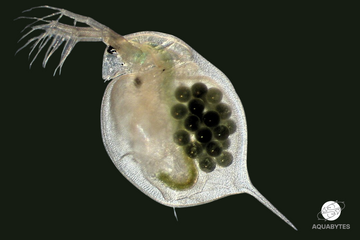For seasoned aquarists, a self-sustaining live food ecosystem isn’t just a convenience—it’s the next level of natural fishkeeping. By cultivating microorganisms, microcrustaceans, and other edible invertebrates directly in your tank, you create a dynamic, renewable food web that enhances fish health, encourages instinctive behaviors, and reduces reliance on manual feeding.
In this article, we’ll dive into how to build a thriving live food ecosystem, focusing on the essential roles of aquatic plants, clean cultures, live sand. When properly combined, these elements do more than beautify your setup—they become the engine of life that keeps your aquarium truly self-sufficient.
Aquatic Plants: Biological Catalysts for Microfauna Production

More Than Just Oxygenators
In freshwater systems, aquatic plants are commonly valued for their roles in nutrient uptake, gas exchange, and algae competition. However, their function as microhabitats for live food organisms is just as significant—particularly in a tank aimed at sustainability. A source of lighting is essential for plants to grow, consider an LED lighting for 6-8 hours daily.
Microbial Biofilms: The Foundation of the Food Web
The surfaces of aquatic plants—especially broad-leaved and finely structured species—serve as prime real estate for biofilm formation. Biofilm is a living matrix of bacteria, fungi, protozoa, and microalgae. It develops on every available surface in a mature aquarium, but plants offer a great medium for it.
Biofilm provides a vital food source, rich in carbohydrates, proteins, lipids, and micronutrients, supporting growth and health. For natural grazers like plecos and shrimp, it offers a continuous, easily accessible food supply, meeting their nutritional needs without extra feeding from the aquarist. The digestive benefits of biofilm go beyond just nutrition. Many fish species, particularly herbivores and omnivores, rely on the microorganisms in biofilm to support gut health.
Species Selection: Designing for Function
Certain plants outperform others in fostering live food production due to their structure and growth habit:
-
Java Moss (Taxiphyllum barbieri): A slow-growing, filamentous plant ideal for fry tanks. Its dense mat catches detritus and harbors a range of micro-critters.
-
Duckweed (Lemna minor): While controversial in high-light setups due to their prolific growth, floating plants offer dangling roots teeming with microorganisms.
Introducing Clean Live Cultures

When it comes to seeding your aquarium with live food organisms, one of the most tempting—and potentially risky—approaches is harvesting from natural sources such as ponds or ditches. While pond water may appear to be a rich source of microfauna, introducing wild-caught specimens into a closed aquarium system often brings more problems than benefits.
The Hidden Dangers of Pond Collection
Natural freshwater bodies are teeming with life, but much of it is uncontrolled and unpredictable. While you may collect desirable species like Daphnia or Cyclops, you're just as likely to introduce:
-
Hydra – Small, tentacled predators that can sting and consume fish fry.
-
Dragonfly and damselfly larvae – Voracious ambush predators that can decimate shrimp colonies and young fish.
-
Planaria and leeches – Difficult to eradicate once established and often harmful to invertebrates.
-
Snail eggs and other nuisance hitchhikers – Which can rapidly overrun an otherwise balanced ecosystem.
These pests are notoriously difficult to detect during collection and can wreak havoc in well-established aquaria.
The Case for Cultured, Single-Species Introductions
For aquarists aiming to build a controlled and sustainable live food web, lab-raised or aquacultured live cultures are a far better solution. AQUABYTES keeps live cultures in enclosed facilities to ensure facility and gut-loaded to prime it for fish feeding. These single-species starter cultures offer several key advantages:
-
Species purity: You know exactly what you’re adding to your tank—nothing more, nothing less.
-
No parasites or predators: Cultures from reputable suppliers are raised in clean, isolated systems.
-
Traceability: You maintain control over what enters your ecosystem, preserving its stability.
Recommended Starter Cultures (Available on AQUABYTES)
-
Daphnia: Ideal for mid-water column feeders; prolific and easy to harvest.
-
Copepods (e.g., Tigriopus, Apocyclops): Excellent for nano fish and fry; also graze on detritus and microalgae.
-
Amphipods (Gammarus, Melita): Hardy bottom-dwellers that feed on detritus and reproduce well in mature systems.
For best results, consider using a separate refugium or culture container to build up populations before introducing them to your display tank. This approach allows you to maintain a steady supply without overtaxing your main ecosystem.
Live Sand: A Substrate of Subtle Abundance
Often underestimated, live sand is a biological treasure trove. It consists of aragonite or similar materials infused with bacteria, microalgae, and a variety of minute invertebrates.

Microfauna Reservoir
Live sand harbors an immense density of microscopic life, including nematodes, tiny worms, micro-crustaceans, and beneficial bacteria. These organisms not only contribute to natural waste breakdown but also provide a renewable snack supply for bottom-feeding species.
Anaerobic and Aerobic Zones
Depending on depth and compaction, sand can support both aerobic and anaerobic bacteria. This layering allows for the natural denitrification process to occur, reducing nitrates and contributing to long-term water stability.




